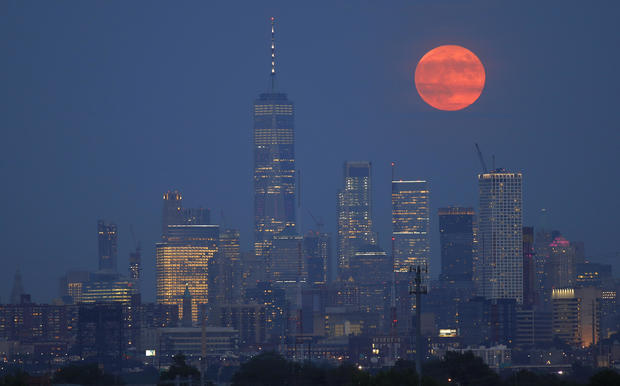BY SOPHIE LEWIS
JULY 3, 2020 / 12:51 PM / CBS NEWS
Fourth of July celebrations look a little bit different this year due to the coronavirus pandemic, but skywatchers are still in for a special Independence Day treat. The weekend brings not only a full moon, but also a lunar eclipse.
The "buck moon" lunar eclipse will be visible the night of July 4 into the morning of July 5. Viewers across most of North and South America, as well as parts of southwestern Europe and Africa, will be able to spot the celestial phenomenon.
The event will be a penumbral eclipse, not a total lunar eclipse, meaning part of the moon will pass through the outer part of Earth's shadow.
According to The Old Farmer's Almanac, July's full moon is called the "buck moon," because early summer is when male deer grow new antlers. It's also called the thunder moon — because of summer storms that occur in July — the guru moon and the hay moon.

On the 50th anniversary of the launch of Apollo 11, the full buck moon rises above the skyline of lower Manhattan and One World Trade Center in New York City on July 16, 2019 as seen from Kearney, New Jersey.GARY HERSHORN / GETTY IMAGES
According to NASA, the full moon will peak early Sunday morning, at 12:30 a.m. EDT. At that time, about 35% of the moon will be in the partial shadow.
The full moon peaks just a few minutes later, appearing opposite the sun at 12:44 a.m. EDT. However, it will appear full all weekend, from Friday evening into Monday morning.
Clear skies will reveal the moon in all its glory, but moon gazers may need the help of a telescope or binoculars for the full effect. It's also possible the events could be overshadowed by Fourth of July fireworks across the U.S. — despite warnings from officials.
Not only does the Fourth of July weekend mark a full moon and lunar eclipse, it also highlights the closest grouping of Saturn, Jupiter and the moon, forming a triangle of celestial celebration.
First published on July 3, 2020 / 12:51 PM
https://www.cbsnews.com/news/how-to-watch-fourth-of-july-weekend-buck-moon-lunar-eclipse/
According to NASA, the full moon will peak early Sunday morning, at 12:30 a.m. EDT. At that time, about 35% of the moon will be in the partial shadow.
The full moon peaks just a few minutes later, appearing opposite the sun at 12:44 a.m. EDT. However, it will appear full all weekend, from Friday evening into Monday morning.
Clear skies will reveal the moon in all its glory, but moon gazers may need the help of a telescope or binoculars for the full effect. It's also possible the events could be overshadowed by Fourth of July fireworks across the U.S. — despite warnings from officials.
Not only does the Fourth of July weekend mark a full moon and lunar eclipse, it also highlights the closest grouping of Saturn, Jupiter and the moon, forming a triangle of celestial celebration.
First published on July 3, 2020 / 12:51 PM
https://www.cbsnews.com/news/how-to-watch-fourth-of-july-weekend-buck-moon-lunar-eclipse/
No comments:
Post a Comment